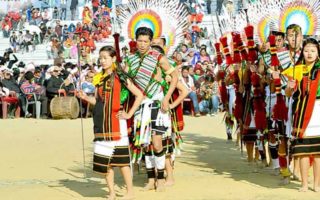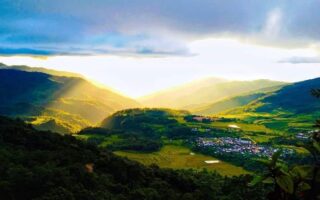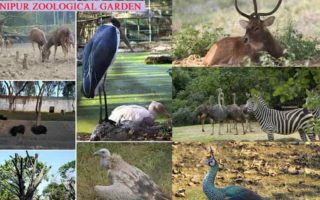At a Glimpse:
- Location: Bishnupur district, Manipur, 53 kilometer from Imphal.
- Established: Year 1977, 28th March.
- Closest town: Imphal and Moirang.
- Coverage area: 40 square kilometer.
- Best season to visit: During the month of November to April.
- Main attraction: Sangai Deer (dancing deer of Manipur).
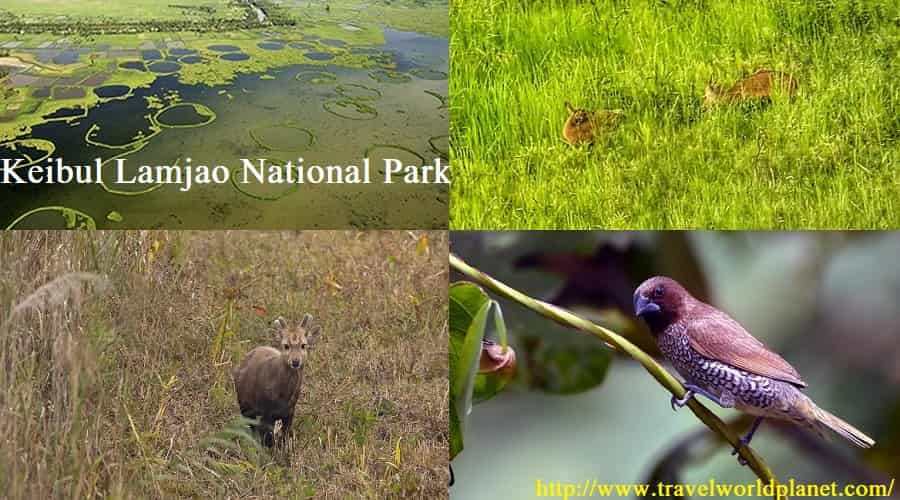
Facts:
The Keibul Lamjao National Park is the most prominent tourist destination to experience the wildlife of Manipur. It is located at a distance of around 53 kilometer from the nearest town Imphal which lies on the boundary of the Loktak Lake. This national park is the only floating park in the entire world, where you can halt at the Loktak Lake. The lake is an amazing spot and also a natural habitat for the “Sangai” Deers, which are renowned as the beautiful dancing deer of Manipur state. Tourists from all around the world come to visit this park just to have a glimpse of the Sangai deer that dwell in this wonderful wetland ecosystem. The dancing deer is not only the main highlight of the national park, but it is also one of the major attractions for visitors. This attraction draws an attention of myriads of people each year. Travelers take a trip from various different states, regions, and countries who hail here for experiencing a mesmerizing vacation. There are several species of animals that have their habitant here; among them some are rare and endangered. The park preserves a wide range of Otter and Hog Deer. Apart from the wildlife, the Keibul Lamjao National Park hosts a number of migratory birds and water fowls that are worth watching here. These species of bird can be spotted only during the months of November to March. The park provides various facilities for visitors where they can closely observe the wild animal and bird species. The Forest Department has upheld two small rest houses and watch towers for sightseeing within the park.
The park stretches an area of around 40 square kilometer which was started during the year 1977. Initially, in the year 1966, the park was well known as a wildlife sanctuary, but later in the year 1977 it was finally established as Keibul Lamjao National Park. This national park of Manipur state is possibly the only floating sanctuary in the whole world. Besides the 40 square kilometer of wetland it also had overgrown deep vegetation measuring around 1.5 meter known as ‘Phumdi’. This enchanting national park contains several marking features that appeal the visitors not only from rest of India, but also from different countries. The main attraction of the national park is terrains and vegetation that call tourists here. Among all the alluring spots the main highlight of the Keibul Lamjao National Park is the Loktak Lake. This lake water contains no salt and is the largest lake in entire India which measure around 6, 475 ha. A large portion of water falls in the park due to which a number of vegetation increases.
Another main attraction of the national park is the Sangai deer, which is known as the dancing deer in the state of Manipur. This species of animals is found only in the state of Manipur and not in other region of India or country. Sangai Deer is simply known as ‘Brow-antlered Deer’ in English. In scientific term, it is called as ‘Cervus eldi eldi Mc Clelland’. This species mostly dwells in the soft and watery wetland of the national park. Majority of the Sangai deer prefer to reside in the southern part of the Loktak Lake. This place is positioned on the seventh rank of the Ramsar sites. A wide range of Sangai is protected and sheltered in the Keibul Lamjao National Park. The dancing deer named as Sangai is considered as the ‘state animal of the state Manipur’ and it is also estimated as the cultural and social identity of this region. There is also some of the ‘Environmental Social Reformation’ and ‘Sangai Protection Forum’ where the folks residing close to the park protect the species from the poachers. So they have formed a non-governmental organization and local clubs. The ‘Environmental Social Reformation’ and ‘Sangai Protection Forum’ is shortly known as ESRSPF. They are spread all along the lake areas.
Flora:
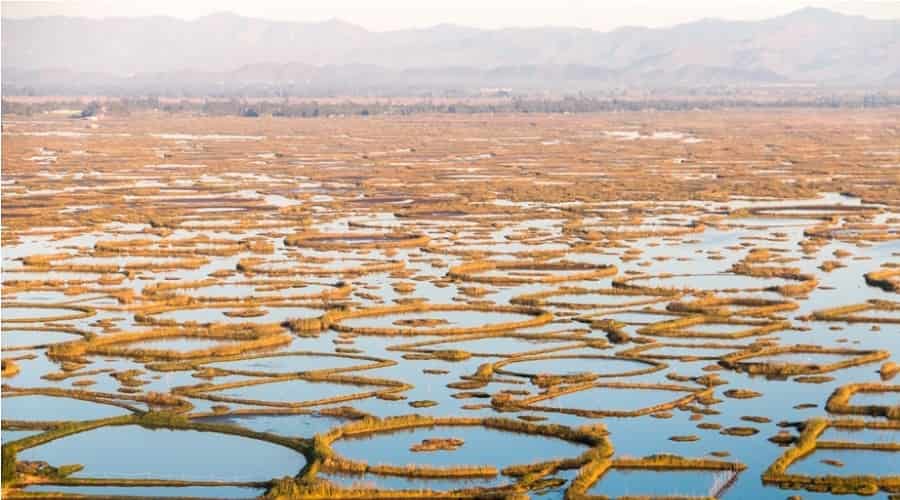
The Keibul Lamjao National park has a wide range of rare and endangered animals that dwell here. It comprises of a unique floating marshes or the most prominent one ‘Phumdi’. In this park, there are a number of vegetation and flora that attracts majority of the tourist. Among all of them 80% of the flora is flooded and a large amount of various kinds of vegetation measures around 90 to 120 cm. they are so thick that it easily covers the upper surface of the water. In the earlier period of times, the most frequent vegetation grown in the national park are fifteen per cent of Khoimon, twenty five per cent of Singut, and forty five per cent of tou. But the makeup of the green vegetation has passes through plant cover and also various rapid changes. In the current days, it is projected to constitute an equal proportion of rich protein plant, ‘ishing kambong Zizania latifolia’, and the ‘hoop Leersia hexandra’, which are often used as a food product around twenty four per cent. The flora and other vegetation’s are popular in the state of Manipur that are found only in Keibul Lamjao National Park. While exploring the park you will spot various vegetations that will increase the knowledge in botany.
Mammals:
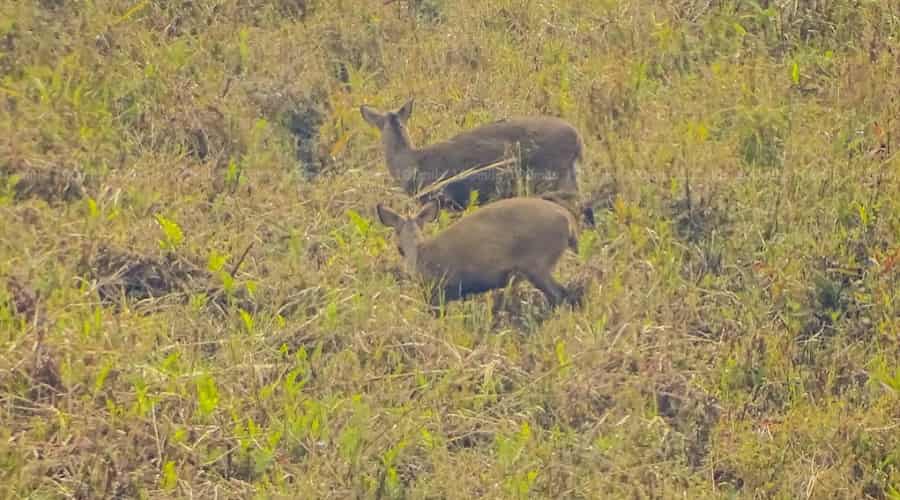
The main attraction of the Keibul Lamjao National Park is the wild animal species and other creatures that have their habitat in this park. There are plenty of wild beasts where there are some of the extreme rare and endangered species which you will encounter within and around the wilderness park. There is another breed of Thamin deer which is also lovingly called as the ‘Manipur’s dancing deer.’ It is said because of its delicate ay of walking and running, and it easily manages from the floating wetlands. Other than the Sangai and Thamin deer species, there are more some of the deer species that you can see here are the muntjac, sambar, and hog deer. One of the most rudest a group of lemurs, tarsiers, monkeys, apes and the human beings, where the stocky lemurs occurs in strewn on the small hills. The Assamese people and short tailed old monkeys and the Hoolock gibbon are limited which are mainly found on the western part of the hillocks. While wandering in the park tourist can easily spot the Rhesus monkeys which are commonly found around and within the park. There are some of the common noted wild animals that reside here like the small Indian civet Viverricula indica, and large Indian civet Viverra zibetha, wild boar Sus scrofa, otter Lutra lutra, and other species that are found in this area. Apart from the all above mentioned wild beast, some of the species of wild cats are very less found in the Keibul Lamjao National Park, they are the Temminck’s golden cat and marbled cat. These two species are very rare and endangered but you cannot sight them easily because they are to be spotted occasionally. One should avoid carrying food items while straying in the national park, because there are some of the species like Malayan bear and the Himalayan black bear that are mostly seen hunting for food. This place will give a mesmerizing vacation for lifetime while you are on tour to Manipur.
Bird Life:
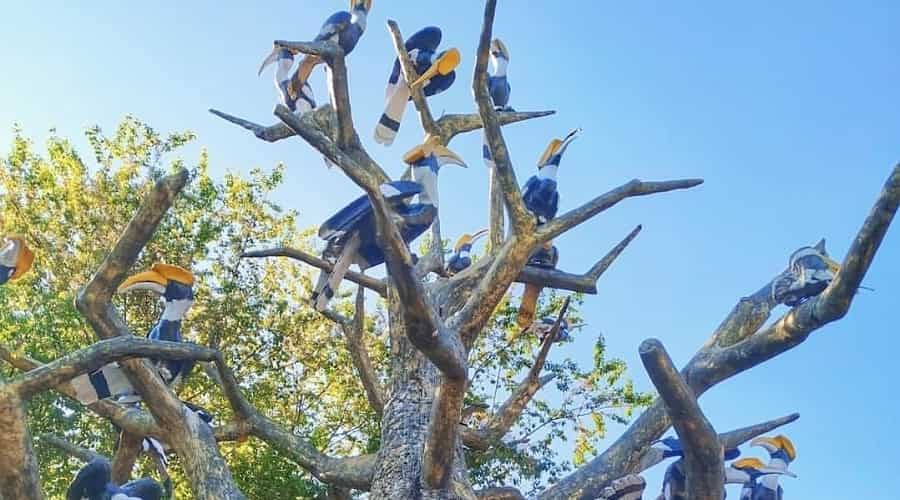
The Keibul Lamjao National Park encloses several attractions of flora, wild animals, and vegetation that are preserved here. If all this are the important elements of this park, then definitely birdlife would be the major attraction. However, around eight per cent of the park is covered with forest where various species of vegetation are planted. Therefore, there are a wide range of rare birds that you will spot while exploring in this park. They are mostly found on the small hill terrains or nestled on tall green trees or near wetlands of Loktak Lake. The bird that belongs to some of the particular region consists mainly of smaller reed abode species. Waterfowl, who migrate from different places, fail to dwell during the winter season due to the lack of water surface. So the number of this waterfowl reduces and become rare. The most commonly seen near the valley of Manipur is the Hooded Crane. Some of the various types of raptor species are also seen here such as the Shaheen Falcon and the Black Eagle. The Green Peafowl, Bamboo Partridge, and the Eastern White Stork are also seen dwelling here. The most amazing species spotted here is of hornbills, there are different types which have their habitat in the Keibul Lamjao National Park are the Great Pied Hornbill, the Pied Hornbill, Wreathed Hornbill, Rufous-Necked Hornbill, and the Brownbacked Hornbill. If you are nature lover and birdwatcher then this park is the perfect place to explore in Manipur state. The scene of bird flying and the chirping sound mesmerize the visitors with charm and pleasure where they can spend their wonderful vacation for lifetime. Don’t miss an opportunity to capture various different bird species in your camera to preserve it as memory.
Ideal Time to Visit:
If you are planning to make a trip to Keibul Lamjao National Park, make sure you visit during the month of October to April. These months are start of winter and summer in India. As mentioned above, you can spot some of the bird and mammal species that migrate here during the winter season. Once you reach here, the best time you can explore all the attractions of the national park is early in the morning or during sunrise, late afternoon but make sure it’s before the sun goes down. After the summer season that is May month, monsoon season starts where the Loktak River gets flooded with rain water and makes it extremely difficult for the visitors to explore. Mostly during the rainy season the park is closed for safer precautions. Definitely tourist will experience one of their alluring and remarkable vacations.
Where to Stay:
The Keibul Lamjao National Park has offered various accommodation facilities within the park. If you want to experience most of the wildlife of Manipur and this national park, make sure you stay in the rest house that are offered by the Forest Department. It is the perfect place to accommodate where you can have a thrilling and wildlife of the Manipur by trip to this park. If you want to spend a private stay, there are several accommodations available closures to the park with full equipped in affordable price.
